
Eristalis is a large genus of hoverflies, family Syrphidae, in the order Diptera. Several species are known as drone flies because they bear a resemblance to honeybee drones.
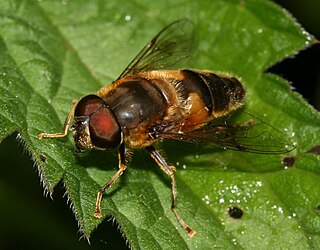
Eristalis pertinax is a hoverfly in the family Syrphidae. It was first described by Giovanni Antonio Scopoli in 1763 and is found in Asia and Europe. Like Eristalis tenax, the larvae of E. pertinax are rat-tailed maggots living in drainage ditches, pools around manure piles, sewage, and similar places containing water with high organic load and low oxygen concentration.

Eristalis arbustorum, the European drone fly, is an abundant Northern Hemisphere species of syrphid fly, originally officially described by Linnaeus in 1758 as Musca arbustorum. The name "drone fly" is related to its similar appearance to the drone of the honeybee. Hoverflies get their names from the ability to remain nearly motionless while in flight. The adults are also known as flower flies as they are commonly found on and around flowers from which they get both energy-giving nectar and protein rich pollen. The larvae are aquatic filter-feeders of the long-tailed type.

Eristalis nemorum is a species of hoverfly. It is found in the Palearctic and in the Nearctic.
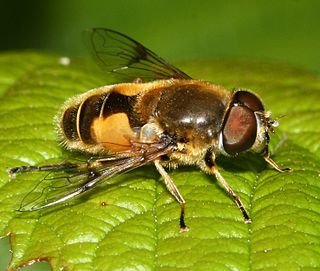
Eristalis horticola is a Palearctic species of hoverfly.

Myathropa florea, sometimes referred to as the Batman hoverfly, is a very common European and North African species of hoverfly. Adults may be seen on flowers from May to September. It is of a similar size to the common drone fly, but Myathropa are generally more yellow, with two light bands to the thorax, interrupted with a black central smudge. In museum specimens, any yellow colour soon fades to brown after death. Like most species in the tribe Eristalini, Myathropa are rather variable in size, shape and colour.

Eristalis intricaria, sometimes called the furry dronefly, is a European species of hoverfly. It is a furry bee mimic, superficially resembling Merodon, though Merodon have all black leg tibiae, as opposed to partly yellow. E. intricaria is somewhat variable in colour pattern, and some attempts at naming varieties have been tentatively made. Flight time of adults in the UK are from March to September. It is generally widespread, but is seldom seen in large numbers. Habitat is woodland or marshland.

Eristalis abusiva is a European species of hoverfly. It is similar to Eristalis arbustorum.
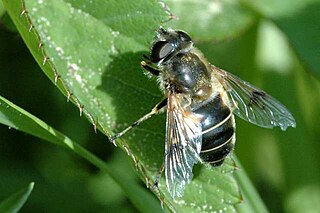
Eristalis rupium, commonly known as the spot-winged drone fly, is a species of syrphid fly that was first described by Fabricius in 1805. It is a common European species, and uncommon in North America. Hoverflies get their names from the ability to remain nearly motionless while in flight. The adults are also known as flower flies as they are commonly found around and on flowers, from which they get both energy-giving nectar and protein-rich pollen. The larvae are aquatic filter-feeders of the rat-tailed type, found in streams with clear water.
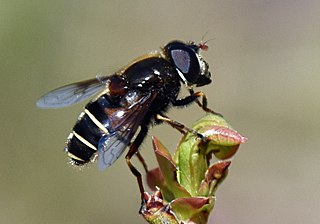
Eristalis cryptarum is a holarctic species of hoverfly. Known as the bog hoverfly or bog-dwelling drone fly, it is a bog specialist but may occur in other wetlands. Its larvae are assumed to live in peat that is saturated with water, such as that found in these boggy areas. The female has been observed depositing eggs on and close to very fresh cow dung along oligotrophic seepages in moorland.

Eristalis flavipes, the orange-legged drone fly, is a species of hoverfly native to North America. It flies from early April to mid-October, and occurs in a wide variety of habitats, particularly wetlands. Hoverflies get their names from the ability to remain nearly motionless while in flight. The adults are also known as flower flies for they are commonly found around and on flowers, from which they get both energy-giving nectar and protein-rich pollen. The larvae are aquatic filter-feeders of the rat-tailed type.
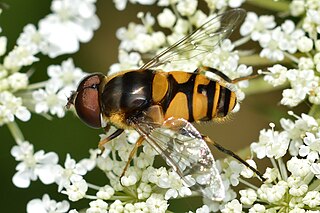
Eristalis transversa, the transverse banded drone fly, is a common species of syrphid fly first officially described by Wiedemann in 1830. Hoverflies get their names from the ability to remain nearly motionless while in flight. The adults are also known as flower flies for they are commonly found around and on flowers, from which they get both energy-giving nectar and protein-rich pollen. The larvae are rat-tailed type but larvae of this specific species has not been reported.

Eristalis bellardii, the Mexican mountain drone fly, is an uncommon species of syrphid fly first officially described by Jaennicke in 1867. It is infrequently found in the Southwestern United States, Mexico and Central America. In appearance it is somewhat like that of a honeybee. Hoverflies get their names from the ability to remain nearly motionless while in flight. The adults are also known as flower flies for they are commonly found around and on flowers, from which they get both energy-giving nectar and protein-rich pollen.

Eristalis dimidiata, the black-shouldered drone fly, is a species of hoverfly native to much of Canada and the eastern and northern United States. It flies year-round in southern areas and from late March to mid-November further north. It is one of the earliest hoverflies to fly in the spring, and as such likely overwinters as an adult. It lives primarily in forests.

Eristalis stipator, the yellow-shouldered drone fly, is a species of hoverfly native to North America. It is abundant in western North America, with a few scattered records in the east. It flies from mid-May to early November, and is known to hilltop.

Eristalis saxorum, the Blue-polished Drone Fly, is an uncommon species of syrphid fly found along the Eastern United States. Hoverflies get their names from the ability to remain nearly motionless while in flight. The adults are also known as flower flies for they are commonly found around and on flowers, from which they get both energy-giving nectar and protein-rich pollen. The larvae are aquatic filter-feeders of the rat-tailed type. The larvae of this species have not been identified. Little is known about this uncommon species which flies from mid-March to late October.
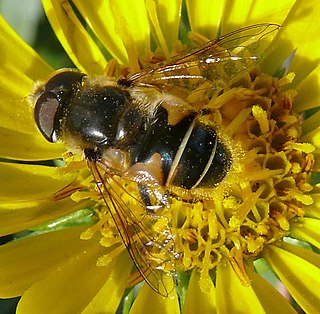
Eristalis hirta, the black-footed drone fly, is a common Western North American species of syrphid fly, first officially described by Loew in 1866. Hoverflies get their names from the ability to remain nearly motionless while in flight. The adults are also known as flower flies as they are commonly found on and around flowers, from which they get both energy-giving nectar and protein-rich pollen. The larvae are aquatic filter-feeders of the rat-tailed type.

Eristalis brousii, also known as the hourglass drone fly, is a fly species in the Syrphidae family first described by Samuel Wendell Williston in 1882. The species has become largely extinct outside of Northern Canada. Eristalis brousii are part of the hoverfly family, known for hovering above flowers to collect nectar and pollen.
Platycheirus varipes is a rare species of syrphid fly observed in Northern Europe: Norway, Sweden, Finland; Greenland; central Asiatic Russia; and in North America from Alaska and Canada south to Colorado, via mountain chains.


















